Varieties of QPM released
Two new quality protein maize (QPM) varieties, designed to thrive in the tropical lowland coffee production zones of southwest Colombia, were released on 14 April 2010. CIMMYT-Mexico developed these two varieties—yellow maize FNC 31AC and white maize FNC 32AC—and the Fundación para la Investigación y Desarrollo Agrícola (FIDAR) evaluated them, under the supervision of Luis Narro of CIMMYT-Colombia. More than 150 people attended the launch event, held at the fields of the International Center for Tropical Agriculture (CIAT) in Palmira, a city in the Cauca Valley, Colombia.
The two varieties yield five tons per hectare, similar to normal maize, but have more tryptophan (0.08% compared to 0.05% of normal maize). Tryptophan is one of two amino acids required for protein synthesis in humans and swine livestock. The release of these QPM varieties is part of the Agrosalud Project, which aims to develop and disseminate biofortified crops, including maize, bean, rice, and sweet potato, and was the result of collaboration with CIMMYT, CIAT, and FIDAR. The National Federation of Colombian Coffee Growers (FENALCE) will take charge of seed production and distribution.
Visits and collaborations at CIMMYT-Colombia
The Global Maize Program’s new director, B.M. Prasanna, continues his travels to CIMMYT’s extensive and wide-spread maize offices. His most recent stop was to CIMMYT-Colombia where from 26-28 April he met with CIMMYTColombia staff and coordinated collaborative activities between CIMMYT and CIAT for Latin America, Asia, and Africa.
Included among other activities was a visit to one of the research stations of the Federación de Cafeteros de Colombia. The experimental station, Centro Nacional de Investigaciones de Café (CENICAFE) La Catalina, is a key area for maize-coffee trails. The director of the station, Carlos Gonzalo Mejía, showed Prasanna (accompanied by Félix San Vicente, maize breeder, and Reymunda Labuguen, program administrator) the fields where since 2002 CIMMYT has collaborated with FEDERECAFE (the National Federation of Colombian Coffee Growers) and FENALCE to sow maize among coffee trees. FENALCE researcher Argemiro Moreno highlighted the benefits of this crop combination, pointing out that maize yields in coffee production zones are high. This year, for example, experimental maize fields at La Catalina yielded 18 tons per hectare.
Agronomic management was another topic of conversation. FENALCE researcher Argemiro Moreno showed staff how to use GreenSeeker, a tool that allows farmers to apply the proper amount of nitrogen to their fields, which he learned about during a recent visit to CIMMYT’s Norman E. Borlaug Experimental Station, in Ciudad Obregón, Sonora, Mexico.
Later, a meeting with Rubén Echeverría, director general of CIAT, led to the conclusion that CIMMYT and CIAT can and should increase collaboration for key areas in Latin America. Highlighted initiatives included 1) improving efficiency in the maize-bean-cattle production systems, 2) efficient utilization of new tools and methods to improve and expedite plant breeding and selection, 3) evaluation and promotion of precision agriculture technologies, and 4) capacity building with students and farmers for faster, effective technology adoption.
To follow-up on these identified issues, the visitor group toured CIAT facilities and met with some of the researchers involved in the emphasized areas, including Michael Peters, tropical forages program leader, Idupulapati M. Rao, physiology and plant nutrition, and Steve Beebe, bean breeder.
Fieldbook course
Two CIMMYT-Colombia team members led a course on Fieldbook during 13-14 May 2010. The course attracted 10 participants, including representatives from two local seed companies, Semivalle and Sem-Latam S.A, and agronomy students from the Corporación Universitaria Santa Rosa de Cabal, Risaralda, Colombia.
Yacenia Morillo, head of Semivalle’s basic research, said that Semivalle will embrace this new knowledge and software, and thanked course organizers Néstor Romero and Alba Lucía for their hard work. Counting this event, CIMMYT has now trained nearly 100 Latin American researchers from public and private organizations in Bolivia, Colombia, Ecuador, and Peru.
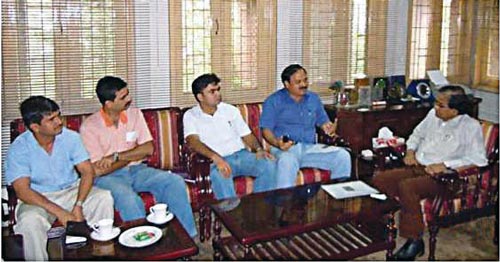
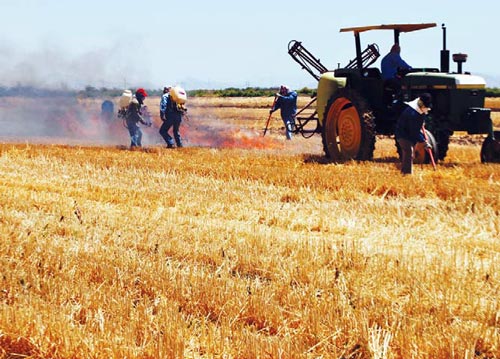 The events were covered by local press and television channels. One topic that generated a lot of interested was stubble burning. The demonstration burning was performed at the Norman E. Borlaug Experiment Station (
The events were covered by local press and television channels. One topic that generated a lot of interested was stubble burning. The demonstration burning was performed at the Norman E. Borlaug Experiment Station (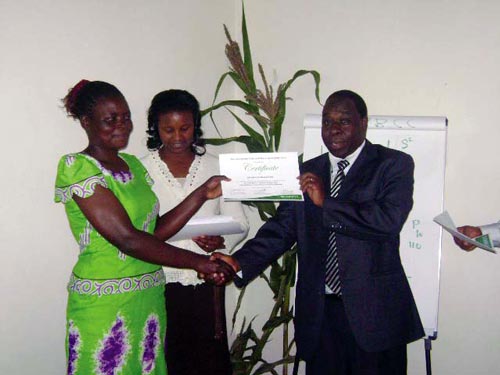 Course participants displayed great enthusiasm and readiness throughout the training. Christine Khalamua (pictured) from KARI-Kakamega expressed her gratitude at having been selected to take part in the training, and was sure that the knowledge acquired during the course will greatly benefit her work. “I have especially learnt a lot about randomization of trials,” she said. The teaching was well supported with images that gave a clear description of the science, said Fred Manyara, a participant from KARI-Embu. “The course covered all activities that maize technicians are involved in. It was very useful and has greatly helped us in understanding the work that we do.”
Course participants displayed great enthusiasm and readiness throughout the training. Christine Khalamua (pictured) from KARI-Kakamega expressed her gratitude at having been selected to take part in the training, and was sure that the knowledge acquired during the course will greatly benefit her work. “I have especially learnt a lot about randomization of trials,” she said. The teaching was well supported with images that gave a clear description of the science, said Fred Manyara, a participant from KARI-Embu. “The course covered all activities that maize technicians are involved in. It was very useful and has greatly helped us in understanding the work that we do.”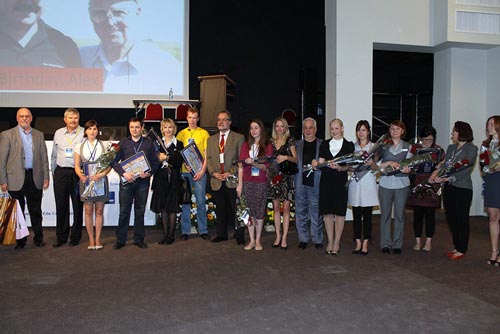 The agenda for day 3 of the event (03 June 2010) was content-lighter, with an afternoon visit to Catherina’s Palace in Carskoe Silo (Pushkin village) , near St. Petersburg. The morning, however, was dedicated to presentations of the 6th session – ‘Biotechnological and genomics tools in wheat improvement.’ Presenters included E. Akhunov, R. DePauw, P.M. Chandler, S. Dresigacker, T. Lumpkin, K. Eversole, P. Sourdille, W. Daowen, and R. Trethowan).
The agenda for day 3 of the event (03 June 2010) was content-lighter, with an afternoon visit to Catherina’s Palace in Carskoe Silo (Pushkin village) , near St. Petersburg. The morning, however, was dedicated to presentations of the 6th session – ‘Biotechnological and genomics tools in wheat improvement.’ Presenters included E. Akhunov, R. DePauw, P.M. Chandler, S. Dresigacker, T. Lumpkin, K. Eversole, P. Sourdille, W. Daowen, and R. Trethowan).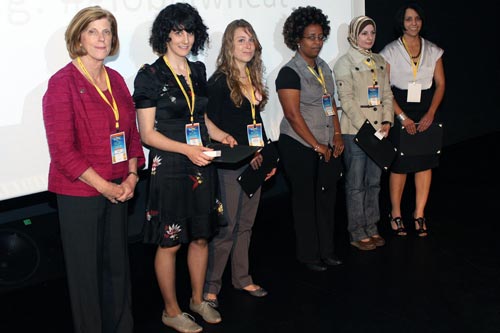 During the special luncheon ‘Jeanie Borlaug Laube’s Women in Triticum Award’ was presented to the first 5 awardees – Hale Ann Tufan (Turkey); Jemanesh Kifetew Haile (Ethiopia); Esraa Alwan (ICARDA), Jessica Rutkoski (USA) and Maricelis Acevedo (USA), followed by special presentation by Eija Pehu (The World Bank) on ‘Gender equity in agricultural research and extension’
During the special luncheon ‘Jeanie Borlaug Laube’s Women in Triticum Award’ was presented to the first 5 awardees – Hale Ann Tufan (Turkey); Jemanesh Kifetew Haile (Ethiopia); Esraa Alwan (ICARDA), Jessica Rutkoski (USA) and Maricelis Acevedo (USA), followed by special presentation by Eija Pehu (The World Bank) on ‘Gender equity in agricultural research and extension’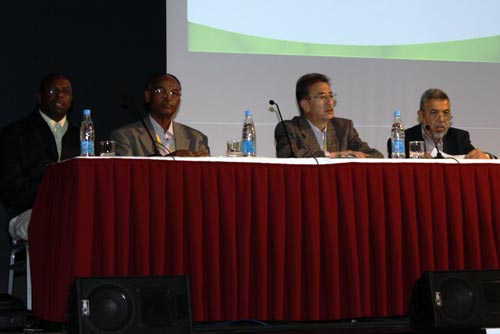 The last session (7) was panel discussion on
The last session (7) was panel discussion on 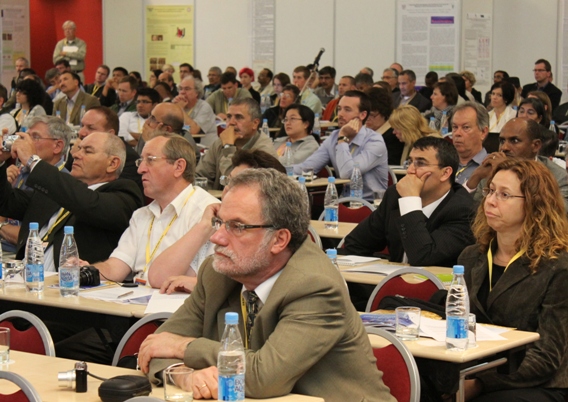 More than 600 wheat breeders, pathologists and representatives of national agricultural research institutions arrived in St. Petersburg to discuss rusts affecting wheat production globally. After introductory remarks byJeanie Borlaug Laube (BGRI chair), Ronnie Coffman (BGRI vice-chair), and Dr. Swapan Datta, DDG (CS) of ICAR, day started with session on ‘World of Rust: Global perspectives’:
More than 600 wheat breeders, pathologists and representatives of national agricultural research institutions arrived in St. Petersburg to discuss rusts affecting wheat production globally. After introductory remarks byJeanie Borlaug Laube (BGRI chair), Ronnie Coffman (BGRI vice-chair), and Dr. Swapan Datta, DDG (CS) of ICAR, day started with session on ‘World of Rust: Global perspectives’: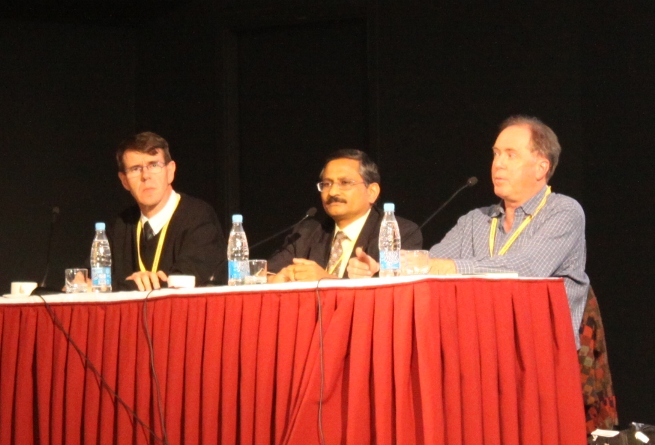
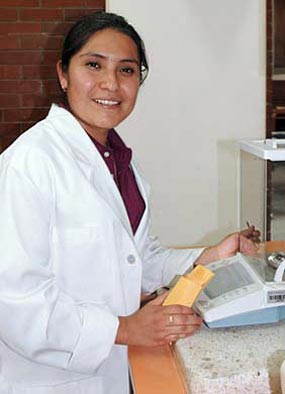 Hernández previously studied agro-industry engineering at the University of Chapingo, Mexico, and she now uses her skills to foil the wheat stem rust Ug99. She has been analyzing biochemical, chemical, and rheological characteristics of specific CIMMYT wheat lines (previously believed to be of little use) to determine which ones have both Ug99 resistance and the quality types that correlate with wheat uses in South Asia. Selected lines will be sent to Asia, where they will be evaluated for yield potential and regional adoption. This work impressed the Monsanto Fund, which is funding Hernández´s trip to St. Petersburg to present her studies and findings.
Hernández previously studied agro-industry engineering at the University of Chapingo, Mexico, and she now uses her skills to foil the wheat stem rust Ug99. She has been analyzing biochemical, chemical, and rheological characteristics of specific CIMMYT wheat lines (previously believed to be of little use) to determine which ones have both Ug99 resistance and the quality types that correlate with wheat uses in South Asia. Selected lines will be sent to Asia, where they will be evaluated for yield potential and regional adoption. This work impressed the Monsanto Fund, which is funding Hernández´s trip to St. Petersburg to present her studies and findings. Over 60 researchers, field technicians, farmers, machinery manufacturers, service providers, and extension workers attended two recent conservation agriculture (CA) training events in Bangladesh. The first event was held at the Bangladesh Agriculture Research Institute (BARI) station in Comilla on 28-29 April, followed by an event at the Wheat Research Centre of BARI in Dinajpur on 04-05 May. The events focused on machinery operation and maintenance, as well as the agronomy of dry direct-seeded rice (DSR). Both were part of joint CIMMYT-
Over 60 researchers, field technicians, farmers, machinery manufacturers, service providers, and extension workers attended two recent conservation agriculture (CA) training events in Bangladesh. The first event was held at the Bangladesh Agriculture Research Institute (BARI) station in Comilla on 28-29 April, followed by an event at the Wheat Research Centre of BARI in Dinajpur on 04-05 May. The events focused on machinery operation and maintenance, as well as the agronomy of dry direct-seeded rice (DSR). Both were part of joint CIMMYT-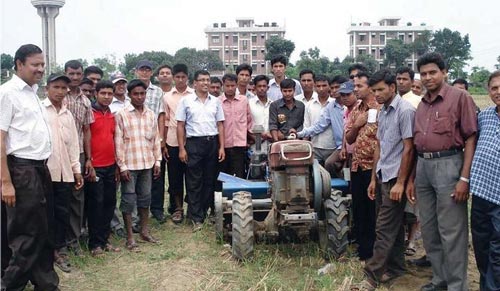 “Machinery operation and maintenance is vital for rapid dissemination of CA-based technologies,” said Jagadish Timsina, IRRI-CIMMYT senior cropping system agronomist. He added that this ACIAR-funded ricemaize project has been adapting and evaluating the PTOS and the bed former/planter at project sites, and has been refining these machines for their use in different soils with the help of agriculture engineers from the national agriculture research intuitions involved in the project. The project has given special emphasis to training and capacity building for machine use and has already trained more than 120 people from government and non-governmental organizations, as well as farmers, service providers, machinery manufacturers, and extension workers since it started in November 2008.
“Machinery operation and maintenance is vital for rapid dissemination of CA-based technologies,” said Jagadish Timsina, IRRI-CIMMYT senior cropping system agronomist. He added that this ACIAR-funded ricemaize project has been adapting and evaluating the PTOS and the bed former/planter at project sites, and has been refining these machines for their use in different soils with the help of agriculture engineers from the national agriculture research intuitions involved in the project. The project has given special emphasis to training and capacity building for machine use and has already trained more than 120 people from government and non-governmental organizations, as well as farmers, service providers, machinery manufacturers, and extension workers since it started in November 2008.
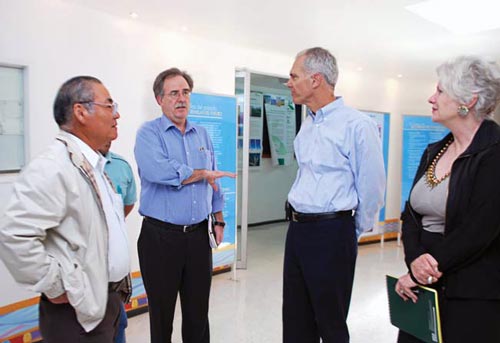 Two members of the new CGIAR Consortium Board, Lynn Haight and Carl Hausmann, visited El Batán during 06-07 May 2010 to meet CIMMYT staff and learn more about the center’s work and culture. Accompanied by CIMMYT Board Chair Julio Berdegué, they toured the facilities and attended general presentations on CIMMYT and on the center’s recently submitted proposals for CG mega programs on maize and wheat. Both said they were happy to visit CIMMYT and impressed with the
Two members of the new CGIAR Consortium Board, Lynn Haight and Carl Hausmann, visited El Batán during 06-07 May 2010 to meet CIMMYT staff and learn more about the center’s work and culture. Accompanied by CIMMYT Board Chair Julio Berdegué, they toured the facilities and attended general presentations on CIMMYT and on the center’s recently submitted proposals for CG mega programs on maize and wheat. Both said they were happy to visit CIMMYT and impressed with the